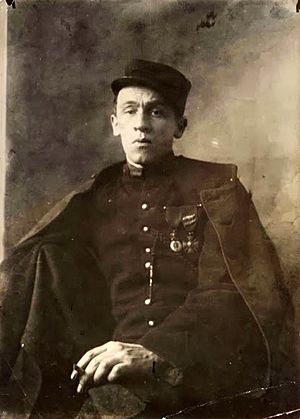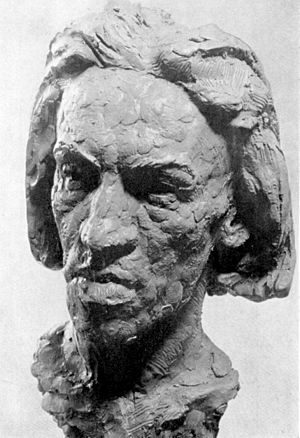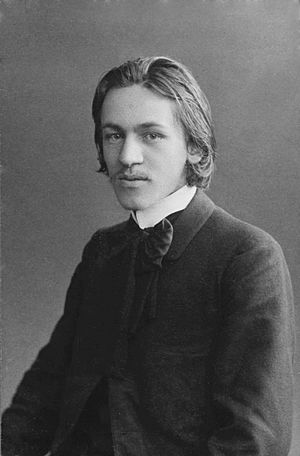Blaise Cendrars facts for kids
Quick facts for kids
Blaise Cendrars
|
|
|---|---|

Cendrars in his army uniform in 1916, after losing his right arm
|
|
| Born | Frédéric-Louis Sauser 1 September 1887 La Chaux-de-Fonds, Neuchâtel, Switzerland |
| Died | 21 January 1961 (aged 73) Paris, France |
| Occupation | Novelist, poet |
| Literary movement | Modernism, Futurism |
Frédéric-Louis Sauser (born September 1, 1887 – died January 21, 1961) was a famous writer and poet. He was born in Switzerland but later became a French citizen in 1916. He is much better known by his pen name, Blaise Cendrars. He was a very important writer in the modernist movement in Europe.
Contents
Early Life and Learning
Blaise Cendrars was born in La Chaux-de-Fonds, Switzerland. His family spoke French, and his father was Swiss, while his mother was Scottish.
His parents sent him to a German boarding school, but he ran away. In 1902, he met his good friend, the sculptor August Suter, in Basel. He then went to another school in Neuchâtel, but he didn't enjoy studying much.
In 1904, he left school because he wasn't doing well. He started learning to be a watchmaker in Russia.
First Writings
While living in St. Petersburg, Russia, Cendrars began to write. A librarian at the National Library of Russia encouraged him. There, he wrote a poem called "La Légende de Novgorode". The librarian translated it into Russian. Cendrars later said he didn't have any copies of it.
In 1907, Cendrars went back to Switzerland. He studied medicine at the University of Berne. During this time, he wrote his first confirmed poems, called Séquences.
A Career in Writing
Cendrars was one of the first writers to use modernist ideas in European poetry. Some of his early works include The Legend of Novgorode (1907) and Les Pâques à New York (1912).
He was a very adventurous writer. He loved to travel and explore new things. He believed that writing should be full of life and real experiences. He admired writers like Balzac and Casanova because their stories were full of life.
Cendrars saw the early modernist art movement, from about 1910 to the mid-1920s, as a time of real discovery. He thought artists like Picasso, Braque, and Léger were very original.
New York and Paris
After a short time in Paris, Cendrars traveled to New York. He arrived there in December 1911. In April 1912, he wrote his important poem, Les Pâques à New York (Easter in New York). This was the first time he used the name Blaise Cendrars.
In the summer of 1912, Cendrars returned to Paris. He was sure that writing poetry was what he wanted to do. He started a journal called Les hommes nouveaux with another writer, Emil Szittya. He met many artists and writers in Paris, like Chagall, Léger, and Modigliani.
He also met Guillaume Apollinaire, another poet. They influenced each other's work. Cendrars' poems were like photographs or movie scenes, with quick changes and strong feelings. His most famous long poem is The Transsiberian. This poem was printed with colorful designs by the painter Sonia Delaunay-Terk. It was a very long fold-out, two meters in length. Cendrars called it the first "simultaneous poem." It was even shown as a work of art.
Cendrars also worked with painters like Chagall and Léger. This led him to write short, abstract poems collected in Dix-neuf poèmes élastiques (Nineteen elastic poems) in 1919.
The Poet Who Lost an Arm
Cendrars' writing career was stopped by World War I. He joined the French Foreign Legion to fight for France. He was sent to the front lines in the Somme region. He wrote about his war experiences in books like La Main coupée (The severed hand).
In September 1915, during attacks in Champagne, Cendrars lost his right arm. He was then released from the army.
After the war, Cendrars became an important part of the art scene in Montparnasse, Paris. He was known for his stories about modern adventurers. He was friends with American writers like Henry Miller and Ernest Hemingway. Hemingway described seeing him rolling a cigarette with his one hand. He was also friends with John Dos Passos, who translated some of Cendrars' major poems for American readers.
In the 1920s, Cendrars started focusing more on novels and short stories. He also traveled a lot to South America. After World War II, he wrote a series of autobiographical books, starting with L'homme foudroyé.
Later Years
Cendrars stayed active in the Paris art community. He encouraged younger artists and wrote about them. During the German invasion in 1940, his book Chez l'armée anglaise was taken by the Gestapo. He had to hide in Aix-en-Provence. Even though the Gestapo listed him as a "Jewish writer," he survived the war. Sadly, his youngest son was killed in an accident while helping American planes in Morocco.
In 1950, Cendrars settled in Paris. He often worked with French radio. His last novel, Emmène-moi au bout du monde !…, was published in 1956. He had a stroke in 1957 and passed away in 1961.
Personal Life
Blaise Cendrars married Féla Poznańska. She was Jewish and from Russia and Poland. They had three children: Rémy, Odilon, and Miriam. Miriam was active with the Free French in London during World War II. She later wrote about her father and helped create the Cendrars Archive in Berne.
Legacy and Honors
- In 1960, he received the title of Commander of the Légion d'honneur for his service in the war.
- In 1961, Cendrars won the Paris Grand Prix for literature.
- His writings are kept in the Swiss Literary Archives in Bern.
- The Centre d'Études Blaise Cendrars (CEBC) was created at the University of Berne to study his work.
- The Lycée Blaise-Cendrars in La Chaux-de-Fonds was named after him.
Works
Here are some of Blaise Cendrars' most important works:
- Les Pâques à New York (1912) – A poem.
- La Prose du Transsibérien et la Petite Jehanne de France (1913) – A famous long poem.
- Séquences (1913) – Poems.
- La Guerre au Luxembourg (1916) – A poem.
- Le Panama ou les aventures de mes sept oncles (1918) – A poem.
- J'ai tué (1918) – A poetic essay.
- Dix-neuf poèmes élastiques (1919) – A collection of poems.
- Anthologie nègre (1921) – A collection of African folk tales.
- L'Or (1925) – A novel, translated as Sutter's Gold.
- Moravagine (1926) – A novel.
- L'ABC du cinéma (1926) – About cinema.
- Petits contes nègres pour les enfants des blancs (1928) – Short stories for children.
- Les Confessions de Dan Yack (1929) – A novel.
- Rhum—L'aventure de Jean Galmot (1930) – A novel.
- Histoires vraies (1937) – True stories.
- L'Homme foudroyé (1945) – A novel.
- La Main coupée (1946) – A novel, translated as The Bloody Hand.
- Bourlinguer (1948) – A novel.
- Le Lotissement du ciel (1949) – A novel.
- Emmène-moi au bout du monde!... (1956) – His last novel, translated as To the End of the World.
See also
 In Spanish: Blaise Cendrars para niños
In Spanish: Blaise Cendrars para niños
- Le Monde's 100 Books of the Century, a list which includes Moravagine
- Swiss literature



